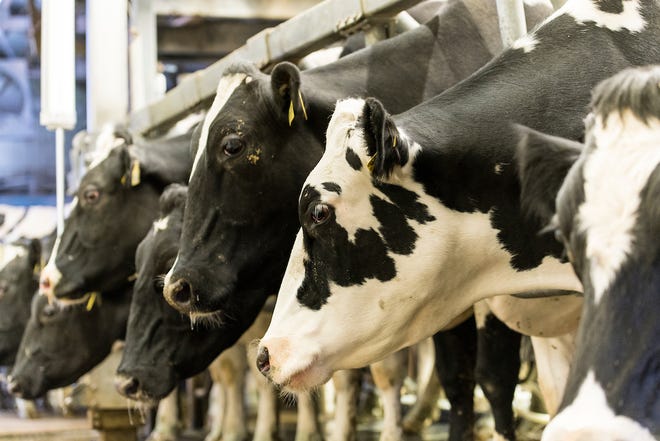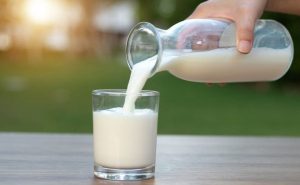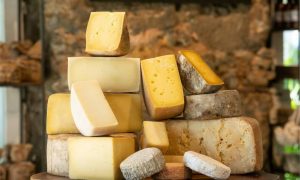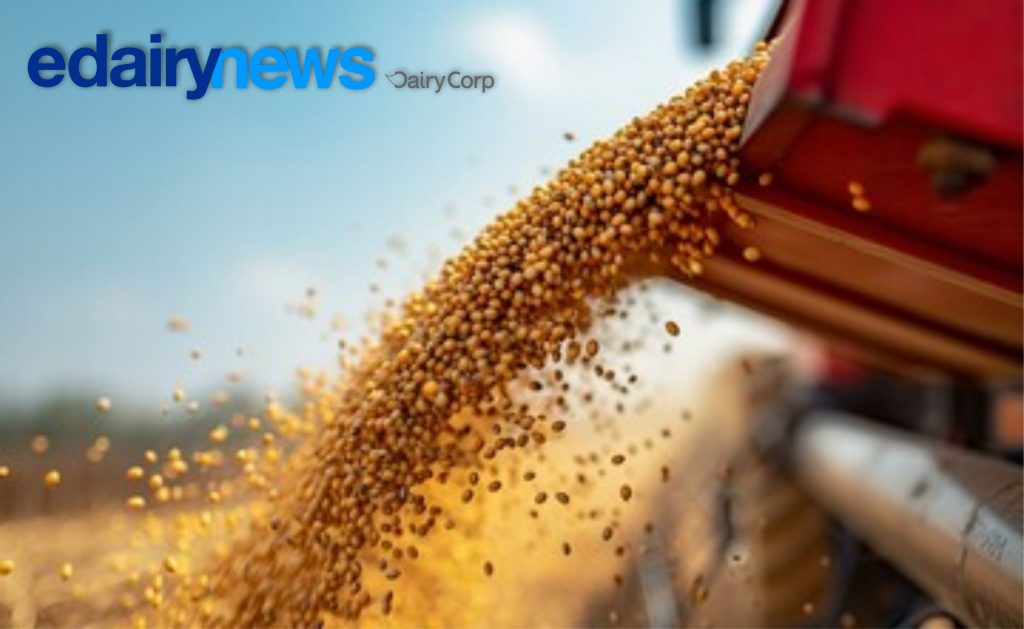Hoards Dairyman Managing Editor Corey Geiger talked about it in the Aug. 31 “Dairy Radio Now” broadcast, saying, “As the COVID pandemic appears in the rearview mirror, there are lessons the dairy industry has learned from it. One of them is creating a more robust supply chain and bolstering communication channels. Another is the federal order system, which wasn’t designed to price milk during a modern-day calamity.
“The original idea behind the Farmers to Families Food Box program was to do as the name implies, provide food to families suffering hardship during the pandemic,” he said. “Along the way, federal government food purchases would prop up prices for farm produce that was hardest hit due to the COVID-19 shockwave. Cheese and other dairy products ranked near the top of that list.”
Unfortunately, Geiger said, “As cheese prices bounded for record price territory, the intended financial rewards never fully arrived on the farm because many cheese plants de-pooled their milk in June and July, via order provisions, and essentially kept the revenue. As a result, record cheese prices induced record negative producer price differentials (PPDs).”
PPD shortfalls combined for a $1.2 billion impact in June and July milk checks, according to Geiger, with the largest jolt in California — a $327 million reduction, followed by the Northeast order at $228 million.
“It will take more than milk price risk tools on the farm to avert this situation,” he argued, “because price mitigation efforts do not cover basis such as PPDs.”
He said that a number of remedies exist but “as we learned in the last farm bill, every adjustment induces another consequence.” He reported that, if the “higher-of” Class III or Class IV pricing provision been in place as it was prior to the 2018 Farm Bill, the Class III would have boosted July’s Class I price over $3 higher.
“As for potential federal order fixes,” Geiger concluded, “Pool qualifications will need significant study. That includes the ability to de-pool and re-pool milk and the associated financial incentives. The pricing relationship between Class I and manufacturing milk will need an in-depth review and that’s just the beginning of the milk price conversations we will need to have in a post-pandemic America.”
Cheese teeter totter
CME block Cheddar climbed to $1.8725 last Wednesday, highest since Aug. 4, but closed Friday at $1.8275 per pound, up 17.75 cents on the week, 42.5 cents below where it was on Aug. 1, and 10.25 cents below a year ago.
The blocks lost 3 cents Monday but inched back up a half-cent Tuesday, to $1.8025, as traders weighed the morning’s GDT and anticipated July’s Dairy Products report on Thursday.
The barrels finished Friday at $1.43, up a dime on the week, 80.5 cents below their Aug. 1 standing and 30.75 cents below a year ago; 12 cars of block were traded last week at the CME and 29 of barrel.
The barrels gained 0.75 cents Monday and duplicated that Tuesday, rising to $1.4450, but 35.75 cents below the blocks.
As I reported last week, Uncle Sam chipped in another $1 billion in food aid. StoneX said in Monday’s “Early Morning Update” that “Round 2 of the food box program has been very positive, but the total program is expected to conclude soon as the bid deadline for Round 3 is September 30th and deliveries must be completed within 30 days after that.
“If this program is to continue then Congress will have to allocate funding for the next fiscal year,” StoneX said. “The main point is that the U.S. government will be buying cheese in September and that, along with what we expect will be some additional ‘value’ buying from commercial interests.”
Dairy Market News reports that Midwestern cheese demand varies. Some producers say they are very busy with orders as markets have buoyed since the large drops earlier in the month. Buyers are active and $2 block cheese is a possibility again, according to DMN.
Others say orders are slowing. Inventories are not burdensome but are growing. Milk availability is mixed but cheese makers expect milk to be plentiful ahead of the Labor Day weekend. The price spread remains “a looming concern.”
Western manufacturers report the barrel supply is “loose” but block supplies are tighter, resulting in the wide price spread. In either case, end users do not seem to have as much trouble finding cheese as they did a few months ago. Cheese is moving well but contacts suggest the market tone is uneasy. Processors say it has become difficult to define true demand. Retail orders are above those of previous years but are cooling. Foodservice sales are still slow, with fast food establishments doing better than seated service.
Exports have improved as U.S. prices converge with international prices. Contacts are eager to see how the next round of government purchases will develop but it’s not clear how much cheese school lunch programs may need with many schools starting virtually this fall. Milk supplies are ample and discounted milk is available with most western plants running at or near capacity.
Butter saw its Friday close at $1.4475, down 6.75 cents on the week, 16 cents below its Aug. 1 perch, and 74.25 cents below a year ago; 43 cars were sold.
Monday’s butter was up 4 cents but gave back 2.25 cents Tuesday, slipping to $1.4650, with 19 cars exchanging hands.
Cold Storage data was the topic of the week for butter traders, according to DMN. Month over month gains were modest but the yearly uptick was notable. Cream availability increased slightly last week and they expect availability to loosen ahead of Labor Day weekend. Food service demand remains in question.
The Western butter market is stable. Prices were unchanged from a week ago even though inventories picked up a bit. Not a lot of change happened on the demand side. Retail sales are still strong, but not as much as in the past month, and food service sales remain lower than usual for this time of the year. Unrest in Portland and Seattle have affected a few high-end restaurants and some were modifying opening schedules while others have closed temporarily. The fires in California are also affecting consumer eating habits and trips to restaurants.
Spot Grade A nonfat dry milk closed Friday at $1.02 per pound, up 2.25 cents on the week but 2.75 cents below a year ago, with 18 sales reported last week.
The powder inched a half-cent higher both Monday and Tuesday, hitting $1.03, highest since July 9.
Cash dry whey saw its Friday closing at 34 cents per pound, up a half-cent on the week but 5 cents below a year ago, with 13 sales reported for the week.
It slipped a half-cent Monday and stayed there Tuesday at 33.50 cents per pound.
GDT down 1.0%
The Global Dairy Trade auction (GDT) started September with a 1.0% decline in its weighted average, which follows the 1.7% decline on Aug. 18. Sellers brought 78.6 million pounds of product to market, up from 69.1 million on Aug. 18, and the highest total since Dec. 17, 2019.
Declines were led by whole milk powder, down 2.0%, after dipping 2.2% on Aug. 18. Butter was down 1.2%, following a 2.0% slip, and anhydrous milkfat was off 0.5%, following a 2.9% drop. GDT Cheddar was down 0.4% after dropping 3.6% in the last event.
Buttermilk powder led the gains, up 3.9%. It did not trade last time. Skim milk powder was up 1.8%, after a 1.1% rise, and lactose was up 0.8%, after falling 3.3% last time.
StoneX Group equated the GDT 80% butterfat butter price to $1.4753 per pound U.S., down 1.6 cents from the last event. CME butter closed Tuesday at $1.4650. GDT Cheddar cheese equated to $1.5551 per pound, down 6.3 cents after losing 5.7 cents in the last event, and compares to Tuesday’s CME block Cheddar at $1.8025. GDT skim milk powder averaged $1.2080 per pound, up from $1.1831, and whole milk powder averaged $1.3080, down from $1.3317. CME Grade A nonfat dry milk closed Tuesday at $1.03 per pound.
Milk ratio jumps
A higher All Milk price more than offset higher feed prices to shoot the July milk feed price ratio higher for the second month in a row and reach the highest level so far this year. The USDA’s latest Ag Prices report put the ratio at 2.69, up from 2.36 in May, and compares to 2.16 in July 2019.
The U.S. All-Milk price averaged $20.50 per hundredweight, up $2.40 from June and $1.80 above July 2019.
California’s All Milk price jumped to $20.90, up $2.20 from June and $2.30 above a year ago. Wisconsin’s, at $22.30, was up $2.80 from June and $3.50 above a year ago.
The national average corn price averaged $3.21 per bushel, up 5 cents per bushel from June but 95 cents per bushel below July 2019. Soybeans averaged $8.51 per bushel, up 17 cents from June and 13 cents per bushel above a year ago. Alfalfa hay averaged $174 per ton, down $5 from June and $9 per ton below a year ago.
The July cull price for beef and dairy combined averaged $70.50 per cwt., down 50 cents from June, $3.50 above July 2019, but was $1.10 below the 2011 base average of $71.60 per cwt.













